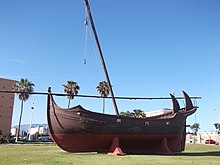History of ship
The first known vessels date back about 10,000 years ago, but could not be described as ships. The first navigators began to use animal skins or woven fabrics as sails. Affixed to the top of a pole set upright in a boat, these sails gave early ships range. This allowed men to explore widely, allowing for the settlement of Oceania for example (about 3,000 years ago).[15]
By around 3000 BC, Ancient Egyptians knew how to assemble wooden planks into a hull.[16] They used woven straps to lash the planks together,[16] and reeds or grass stuffed between the planks helped to seal the seams.[16][17] The Greek historian and geographer Agatharchides had documented ship-faring among the early Egyptians: "During the prosperous period of the Old Kingdom, between the 30th and 25th centuries B. C., the river-routes were kept in order, and Egyptian ships sailed the Red Sea as far as the myrrh-country."[18] Sneferu's ancient cedar wood ship Praise of the Two Lands is the first reference recorded (2613 BC) to a ship being referred to by name.[19]
The ancient Egyptians were perfectly at ease building sailboats. A remarkable example of their shipbuilding skills was the Khufu ship, a vessel 143 feet (44 m) in length entombed at the foot of the Great Pyramid of Giza around 2500 BC and found intact in 1954.
It is known that ancient Nubia/Axum traded with India, and there is evidence that ships from Northeast Africa may have sailed back and forth between India/Sri Lanka and Nubia trading goods and even to Persia, Himyar and Rome.[20] Aksum was known by the Greeks for having seaports for ships from Greece and Yemen.[21]
Elsewhere in Northeast Africa, the Periplus of the Red Sea reports that Somalis, through their northern ports such as Zeila and Berbera, were trading frankincense and other items with the inhabitants of the Arabian Peninsula well before the arrival of Islam as well as with then Roman-controlled Egypt.[22]
A panel found at Mohenjodaro depicted a sailing craft. Vessels were of many types; their construction is vividly described in the Yukti Kalpa Taru, an ancient Indian text on shipbuilding. This treatise gives a technical exposition on the techniques of shipbuilding. It sets forth minute details about the various types of ships, their sizes, and the materials from which they were built. The Yukti Kalpa Taru sums up in a condensed form all the available information. The Yukti Kalpa Taru gives sufficient information and dates to prove that, in ancient times, Indian shipbuilders had a good knowledge of the materials which were used in building ships. In addition to describing the qualities of the different types of wood and their suitability for shipbuilding, the Yukti Kalpa Taru gives an elaborate classification of ships based on their size.
The oldest discovered sea faring hulled boat is the Late Bronze Age Uluburun shipwreck off the coast of Turkey, dating back to 1300 BC.[23]
The Phoenicians, the first to sail completely around Africa, and Greeks gradually mastered navigation at sea aboard triremes, exploring and colonizing the Mediterranean via ship. Around 340 BC, the Greek navigator Pytheas of Massalia ventured from Greece to Western Europe and Great Britain.[24] In the course of the 2nd century BC, Rome went on to destroy Carthage and subdue the Hellenistic kingdoms of the eastern Mediterranean, achieving complete mastery of the inland sea, that they called Mare Nostrum. The monsoon wind system of the Indian Ocean was first sailed by Greek navigator Eudoxus of Cyzicus in 118 BC.[25]
In China, by the time of the Zhou Dynasty ship technologies such as stern mounted rudders were developed, and by the Han Dynasty, a well kept naval fleet was an integral part of the military. Ship technology advanced to the point where by the medieval period, water tight compartments were developed.
The Swahili people had various extensive trading ports dotting the coast of medieval East Africa and Great Zimbabwe had extensive trading contacts with Central Africa, and likely also imported goods brought to Africa through the Southeast African shore trade of Kilwa in modern-day Tanzania.[26]
It is known by historians that at its height the Mali Empire built a large naval fleet under Emperor Mansa Musa in the late 13th and early 14th century.[27] Arabic sources describe what some consider to be visits to the New World by a Mali fleet in 1311.[28]
Before the introduction of the compass, celestial navigation was the main method for navigation at sea. In China, early versions of the magnetic compass were being developed and used in navigation between 1040 and 1117.[29] The true mariner's compass, using a pivoting needle in a dry box, was developed in Europe no later than 1300.[30][31]
U could have become a history lecturer.. Tho for the lesson!
Tho thanks for the history.
Lol really tank u